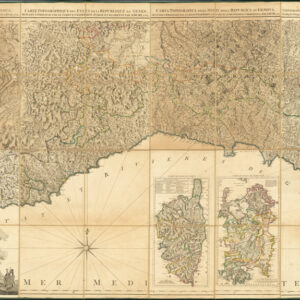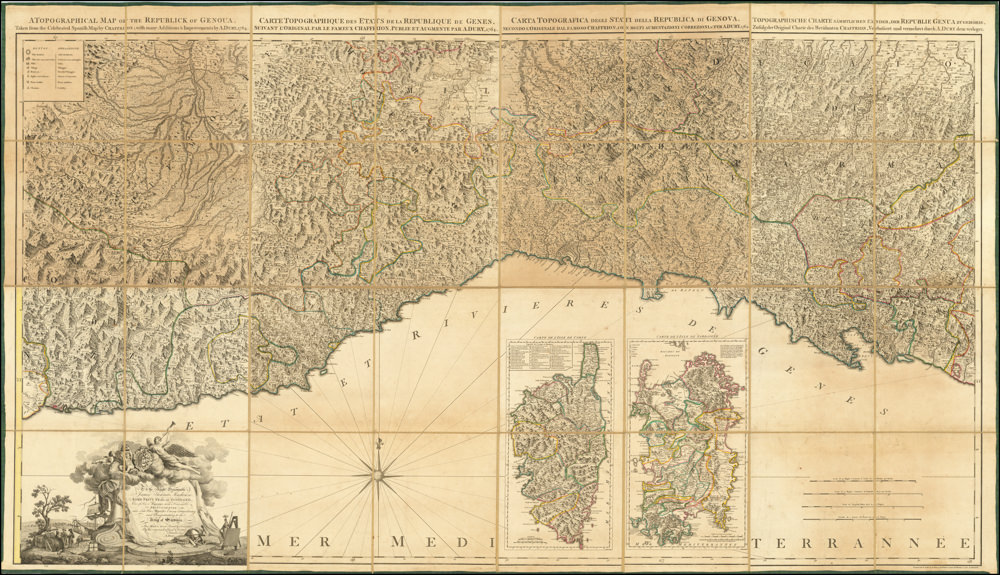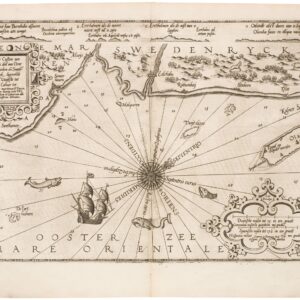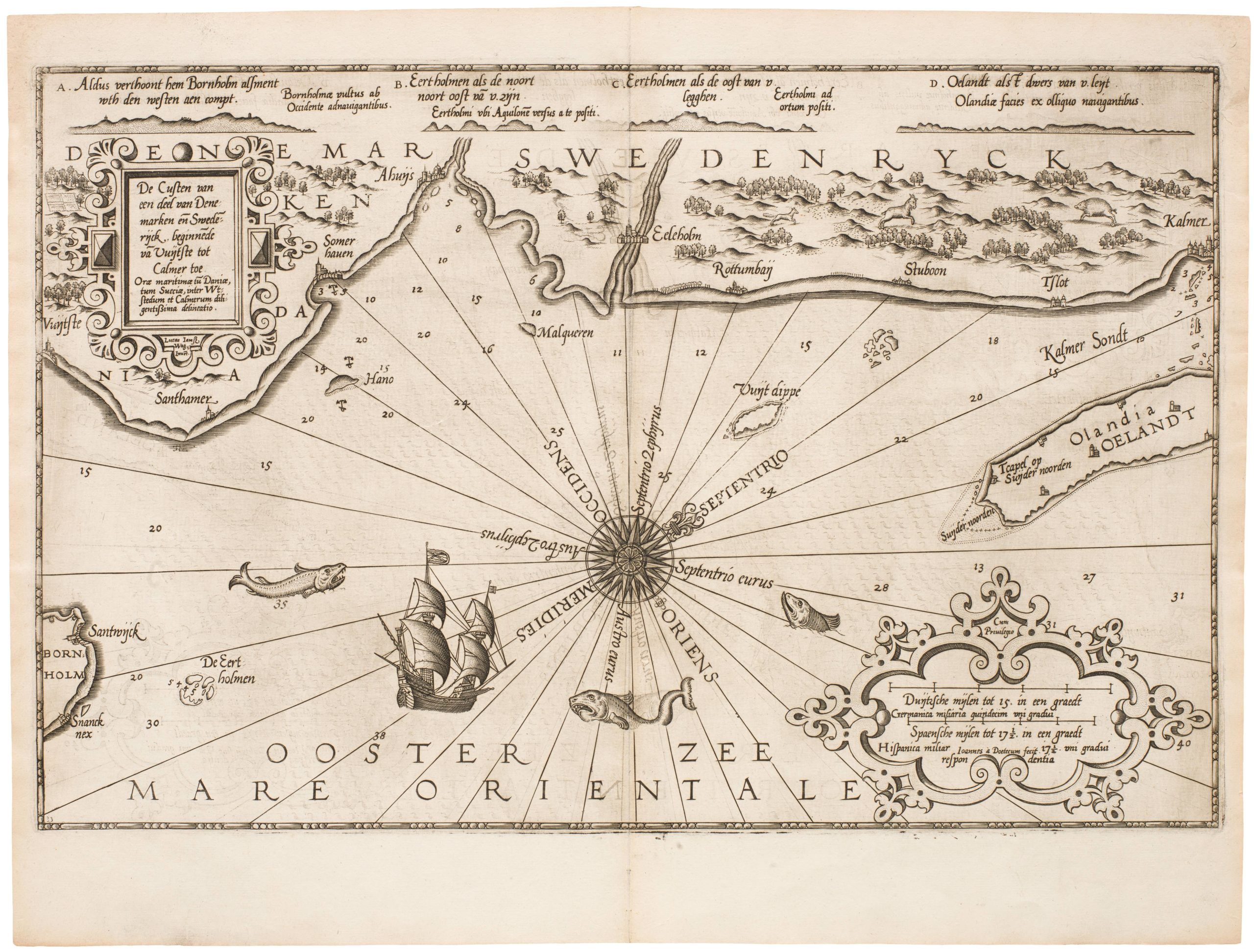Blending the Renaissance concept of Ancient Greece with more recent historical developments in the East Mediterranean.
Nou Grecia secondo tutte regioni, & provinicie di quella di qua…
$875
1 in stock
Description
This charming 16th-century woodblock map of Greece and the Aegean littoral (including Crete) was created by the renowned German cartographer and scholar Sebastian Münster. The map was carved for Münster’s Ptolemaic atlas: Cosmographia Universalis, the first edition of which was published in Basel in 1544. The Greece map created for the new Cosmographia was an updated version of Münster’s Typus Greciae from the 1538 edition of Solinus’ Polyhistor.
Neatline’s example of the map comes from the first Italian language edition of the Cosmographia, which was published in 1558. In the later editions of Münster’s Ptolemaic atlas, the original Greece (Tabula Europae X) and Anatolia maps (Tabula Asiae I) were amalgamated to produce a new view of the entire Aegean littoral. This was initially named Nova Grecia XXII – Nova Tabula, but was later given a variety of titles based on the language of the publication.
The cartographic details of Sebastian Münster’s map are notable for their accuracy, given the limited knowledge and resources available during the 16th century. The map includes a range of geographical features and political divisions, displaying kingdoms, principalities, and city-states not of the 16th century but of the Classical World that Ptolemy occupied. Consequently, we find ancient Greek cities such as Athens, Sparta, Corinth, and Thebes as well as Hellenistic centers in Asia Minor like Ephesus and Troy. It also showcases the large islands of Crete, Rhodes, as well as the Aegean Archipelago.
The map conforms to the Ptolemaic worldview in that it maintains a highly schematic rendition. Unlike many Late Renaissance maps, we find no ornate title cartouches, scale bars, and compass roses precisely because distances and locations were pre-established by the Ptolemaic narrative. The map is nevertheless characterized by extensive stylized topographic features such as mountains and rivers, and many of the largest cities are depicted in the classic Germanic pictorial style of the 16th century. In the rendition of the cities, the map departs somewhat from its ancient outlook by making the old Ottoman capitals of Bursa and Adrianople (Edirne) the largest cities on the map. Constantinople, on the other hand, while having fallen to the Ottomans a century earlier, enjoys no more prestige than its Chalcedonian counterpart across the Hellespont.
Cartographer(s):
Sebastian Münster (1488-1552) was a cosmographer and professor of Hebrew who taught at Tübingen, Heidelberg, and Basel. He settled in Basel in 1529 and died there, of the plague, in 1552. Münster was a networking specialist and stood at the center of a large network of scholars from whom he obtained geographic descriptions, maps, and directions.
As a young man, Münster joined the Franciscan order, in which he became a priest. He studied geography at Tübingen, graduating in 1518. Shortly thereafter, he moved to Basel for the first time, where he published a Hebrew grammar, one of the first books in Hebrew published in Germany. In 1521, Münster moved to Heidelberg, where he continued to publish Hebrew texts and the first German books in Aramaic. After converting to Protestantism in 1529, he took over the chair of Hebrew at Basel, where he published his main Hebrew work, a two-volume Old Testament with a Latin translation.
Münster published his first known map, a map of Germany, in 1525. Three years later, he released a treatise on sundials. But it would not be until 1540 that he published his first cartographic tour de force: the Geographia universalis vetus et nova, an updated edition of Ptolemy’s Geography. In addition to the Ptolemaic maps, Münster added 21 modern maps. Among Münster’s innovations was the inclusion of map for each continent, a concept that would influence Abraham Ortelius and other early atlas makers in the decades to come. The Geographia was reprinted in 1542, 1545, and 1552.
Münster’s masterpiece was nevertheless his Cosmographia universalis. First published in 1544, the book was reissued in at least 35 editions by 1628. It was the first German-language description of the world and contained 471 woodcuts and 26 maps over six volumes. The Cosmographia was widely used in the sixteenth and seventeenth centuries and many of its maps were adopted and modified over time, making Münster an influential cornerstone of geographical thought for generations.
Condition Description
Excellent condition with dark impression; one chip in upper right corner.
References


![[Map of Steamship Routes and the Railways and Post Roads of the Russian Empire]](https://neatlinemaps.com/wp-content/uploads/2020/04/NL-00827_Thumbnail-300x300.jpg)
![[Map of Steamship Routes and the Railways and Post Roads of the Russian Empire]](https://neatlinemaps.com/wp-content/uploads/2020/04/NL-00827-scaled.jpg)
![[Map of Steamship Routes and the Railways and Post Roads of the Russian Empire]](https://neatlinemaps.com/wp-content/uploads/2020/04/NL-00827-scaled-300x300.jpg)


